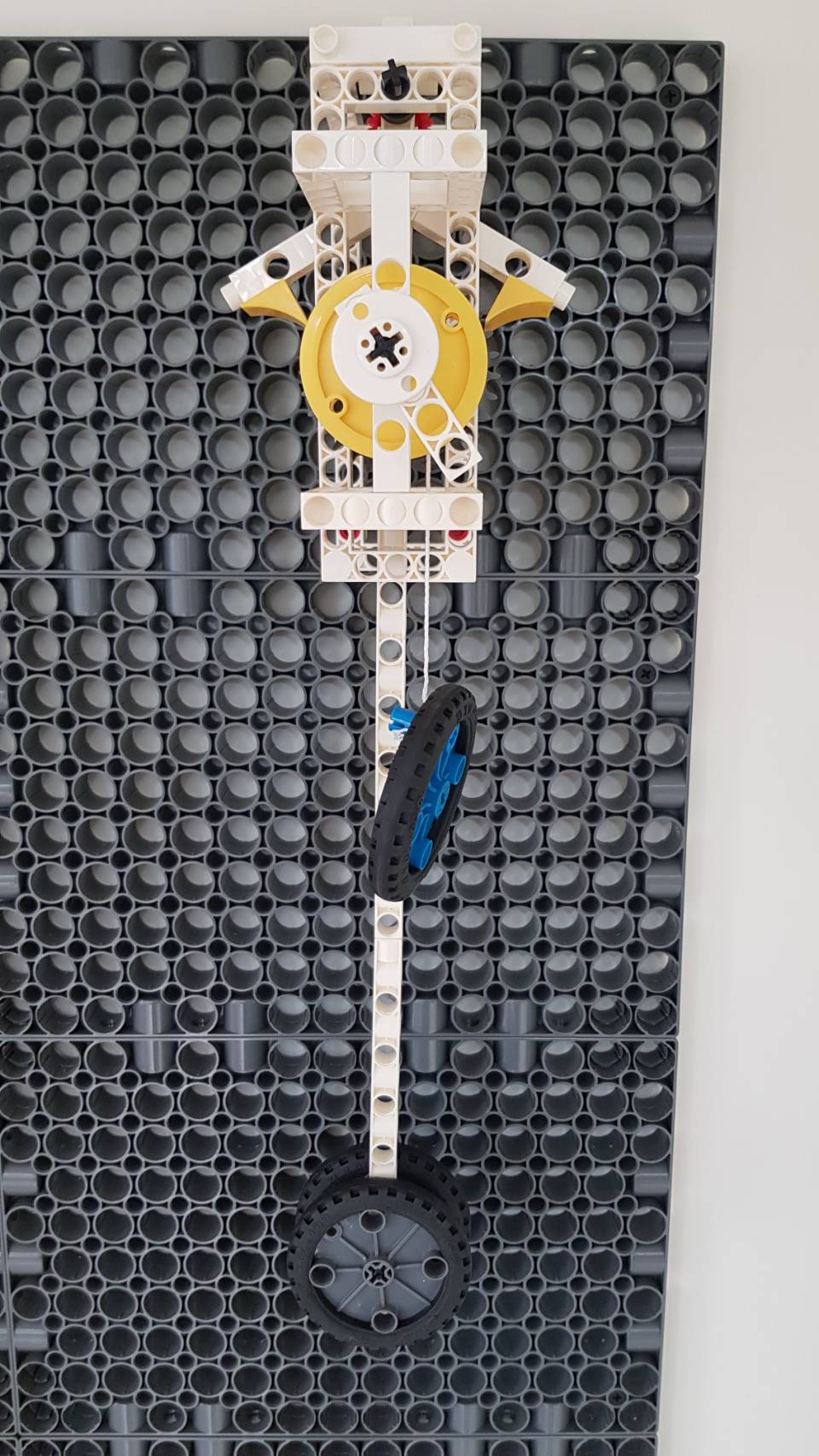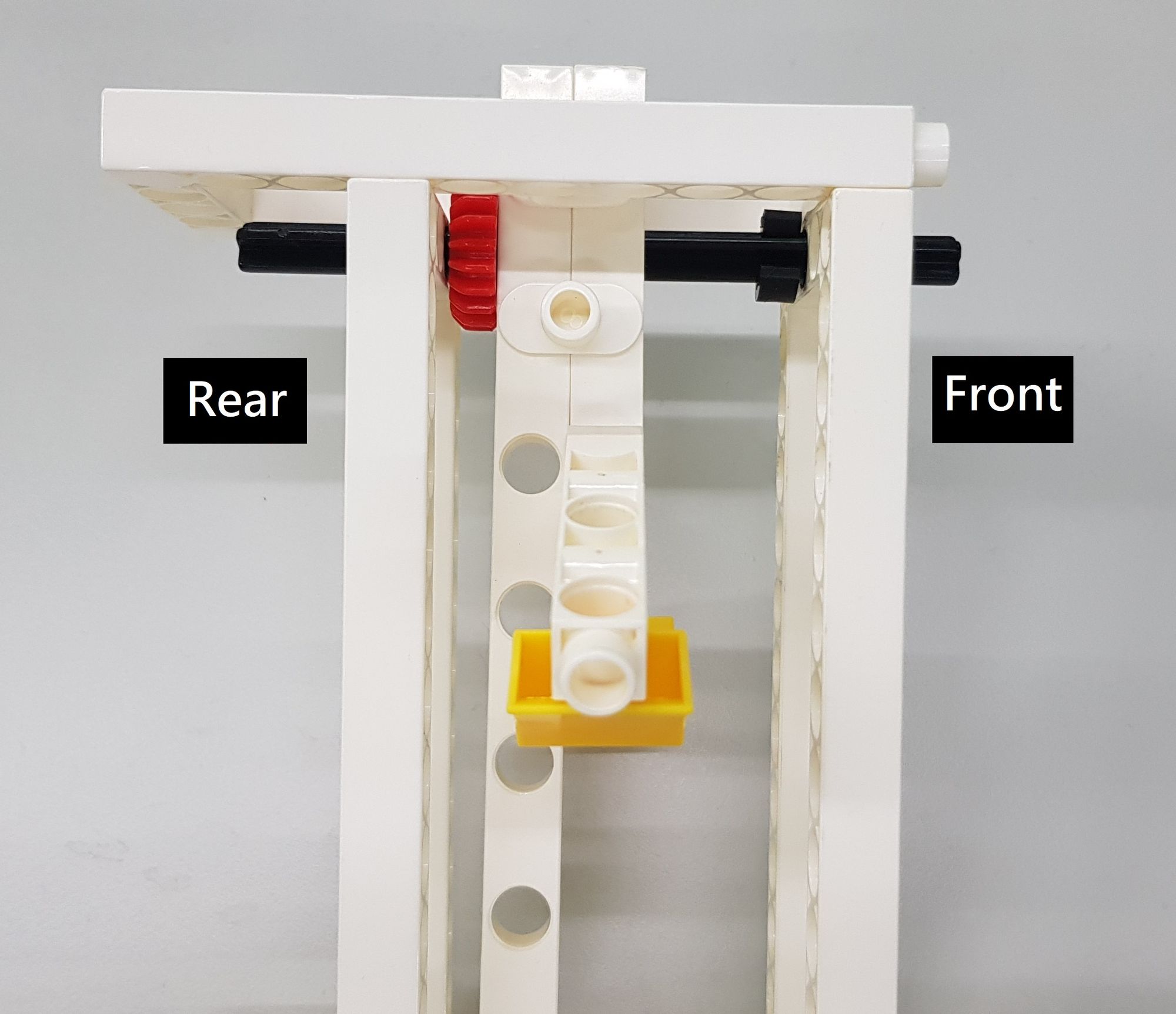Science in daily life: EP2-Gravity Pendulum Clock

Hello everyone, I'm Teacher Raccoon. Throughout history, humans have utilized various methods of measuring time to establish daily routines. Since ancient times, people have relied on the position of the sun to gauge the time of day, giving rise to the popular saying of working at sunrise and resting at sunset. Over time, tools such as sundials, hourglasses, pocket watches, and mechanical clocks were invented to provide more precise timekeeping. Of these devices, my personal favorite is the pendulum clock, which employs the escapement system. Today, we will use building blocks to construct a gravity pendulum clock that operates through the power of gravity!
It's like a real clock running. Isn't it cool?
Now follow me to make a gravity pendulum clock.
◆Assembly Steps
First, we need to prepare a C-5X15 FRAME, a C-5X10 FRAME and a C-3 HOLE DUAL ROD (Figure 1). After connecting them, the main structure of the pendulum clock is completed (Figure 2).


In the second step, we use the B-CONCAVE of the two-centimeter system, the C-5 HOLE DUAL ROD of the one-centimeter system, and the C-HALF HEXAGON CONNECTOR (7432-W10-B1W) (Figure 3). We can make a simple escapement structure with these parts (Figure 4).


In the third step, we use the C-RACING TIRE and the C-15 HOLE DUAL ROD (Figure 5). After extending the C-15 HOLE DUAL ROD, we combine the two C-RACING TIRE with 30mm axle, which is the main part of the pendulum (Figure 6). It’s recommended to change the height of the two racing tires and observe the relationships between the height of tires and the swinging frequency of the pendulum.


In the fourth step, we use four C-TWO-IN-ONE CONVERTER (Figure 7) to combine the escapement with the pendulum (Figure 8), so that the escapement and the pendulum can swing synchronously.


In the fifth step, we need to use the C-100mm AXLE , C-20T GEAR and C-AXLE FIXING (Figure 9). Insert the long axle from the front of the pendulum clock, and put the C-AXLE FIXING, escapement pendulum group and 20T gear in order (Figure 10).


In the sixth step, we use a C-5X5 FRAME and various rods (Figure 11) to form two parts (Figure 12) as the fixed point of the second long axle, so we need to fix them to the front of the pendulum clock as shown (Figure 13).



In the seventh step, we need to use C-30T CHAIN GEAR, C-OD53mm PULLEY, C-100mm AXLE, C-AXLE FIXING and cotton rope (Figure 14). Insert the long axle from the rear into the frame, and tie the cotton rope between the two pulleys. Please make sure the direction of the pulleys is correct (Figure 15).


After completing the configuration, we can fit the two pulleys tightly, and pass the cotton rope through the holes of the pulleys to complete the assembly of the cable groove (Figure 16).

Finally, install the C-30T CHAIN GEAR and C-AXLE FIXING as shown (Figure 17). The C-30T CHAIN GEAR can function as an escape wheel here and cooperate with the escapement system.

In the eighth step, we will use the C-RACING TIRE and the C-AXLE CONNECTOR (Figure 18). Because we are going to make a gravity pendulum clock, we need a counterweight as the swinging power of the pendulum clock. Combine the C-RACING TIRE and cotton rope through the C-AXLE CONNECTOR (Figure 19) to add the counterweight. You can try to use counterweights of different weights, and observe the relationship between the counterweights and the swing frequency of the pendulum clock.


In the ninth step, we use the C-LONG PEG, the C-ROD CONNECTOR and the C-5 HOLE ROD (Figure 20). The C-LONG PEG is used to fix the pendulum clock, and the C-ROD CONNECTOR and the C-5 HOLE ROD can make a second hand, and then we can observe the swinging situation more easily (Figure 21).


In this way, the gravity pendulum clock is done. We can fix it on the JUMBO BASE GRID WALL through the LONG PEG, and then we will "wind it up". Move the 20T gear and escapement to the rear, and then rotate the long axle counter-clockwisely to let the pulley roll up the cotton rope with the counterweight, and then push the 20T gear and escapement back to the front to ensure that the B-CONCAVE and the 30T CHAIN GEAR touch each other (Video 1).
If your gravity pendulum clock cannot operate smoothly, you can adjust the position of the escapement, that is, the angle of the B-CONCAVE or the C-5 HOLE DUAL ROD (Figure. 22), so that the pendulum only slightly touches the top of the 30T CHAIN GEAR when performing a simple pendulum movement.

You can also add hooks on the back of the pendulum clock (Figure 23) so that it can be hung on a partition or wall (Video 2)!

◆Conclusion
Clocks serve as a means of telling time and can aid in the development of a healthy daily routine. The evolution of clocks spans a significant period in history, and as such, we can observe the use of various scientific principles and mechanical structures in their development. Similar to clocks, many everyday inventions have been crafted through the accumulation of wisdom over time. It is due to the hard work and dedication of those who came before us that we are able to enjoy the convenience of modern life.
◆Scientific principles
The gravity pendulum clock operates on the scientific principles of the simple pendulum and the escapement system. The concept of the simple pendulum was initially put forth by Galileo, who discovered that its swing adheres to a specific law and that its period is proportional to the length of the rope - this phenomenon is known as the "isochronism of the pendulum." The escapement system, which is the key mechanical structure of early pendulum clocks, can be traced back to Greece. It consists of an escape wheel and an escapement, which allows the escape wheel to rotate at a fixed frequency through the periodic swing of a single pendulum, producing a motion similar to that of a second hand.
◆Curriculum:
3-PS2-1 Plan and conduct an investigation to provide evidence of the effects of balanced and unbalanced forces on the motion of an object.
MS-PS2-4 Construct and present arguments using evidence to support the claim that gravitational interactions are attractive and depend on the masses of interacting objects.
MS-PS2-2 Plan an investigation to provide evidence that the change in an object’s motion depends on the sum of the forces on the object and the mass of the object.
◆Reference:



Please sign in to vote.

